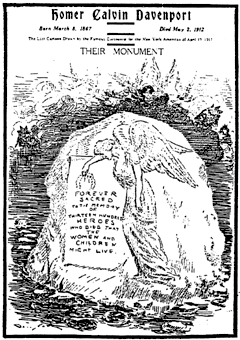 Davenport
spent a good deal of time traveling in Europe, and on one of his trips
he attended the Dreyfus trial, sketching the principal characters. He also
visited England and caricatured some of the prominent statesmen there,
including Gladstone, Sir William Harcourt, Balfour, and others. Recently
he had gone back to the Hearst forces, and was engaged on the New York
American. His last cartoon, and the one which probably cost him
his life, was on the Titanic disaster. He had gone down to the dock
the night the Carpathia was due and there caught a cold, which turned
into pneumonia and resulted in his death. Davenport
spent a good deal of time traveling in Europe, and on one of his trips
he attended the Dreyfus trial, sketching the principal characters. He also
visited England and caricatured some of the prominent statesmen there,
including Gladstone, Sir William Harcourt, Balfour, and others. Recently
he had gone back to the Hearst forces, and was engaged on the New York
American. His last cartoon, and the one which probably cost him
his life, was on the Titanic disaster. He had gone down to the dock
the night the Carpathia was due and there caught a cold, which turned
into pneumonia and resulted in his death.
Born
in the little town of Silverton, Oregon, in 1867, Davenport was forty-five
years of age at the time of his death. Besides his cartoon work, he had
also written several books, among which were "The Diary of a Country
Boy," "The Bell of Silverton and Other Stories of Oregon,"
and "The Dollar or the Man." He occasionally lectured on the
influence and work of the cartoonist. Davenport was very fond of country
life and a great lover of animals. On his stock farm in New Jersey he raised
fancy poultry and bred horses and other animals. In 1906, he visited Arabia
and brought over, with the Sultan's especial permission, a string of twenty-seven
Arabian horses, said to be the only genuine horses of this type in America.
Had Mr. Davenport lived, he would undoubtedly have given us some brilliant
work during the coming Presidential campaign. His death removed a potent
force in American journalism, and a most picturesque and popular member
of his craft.
|